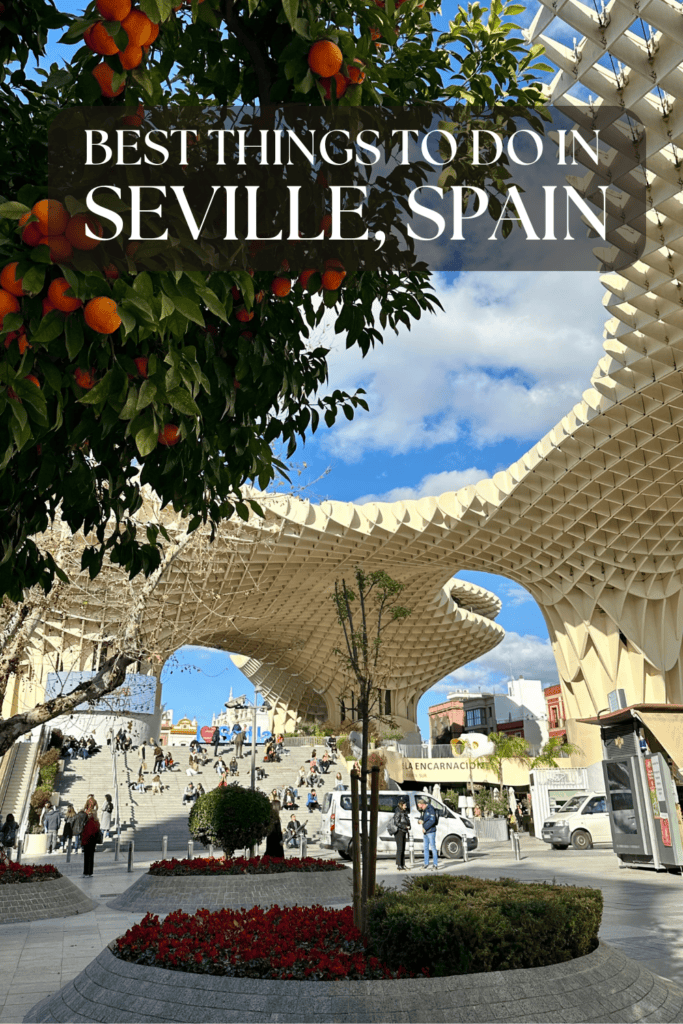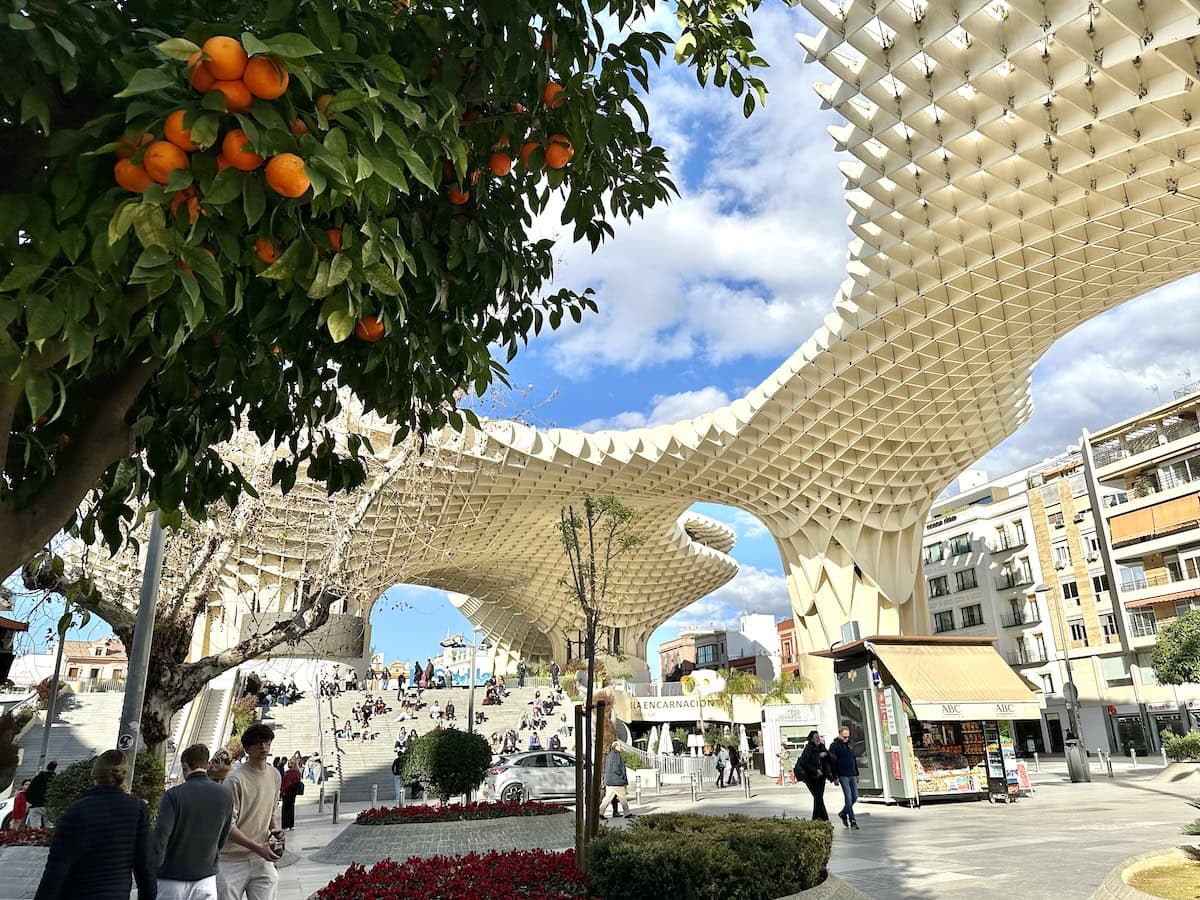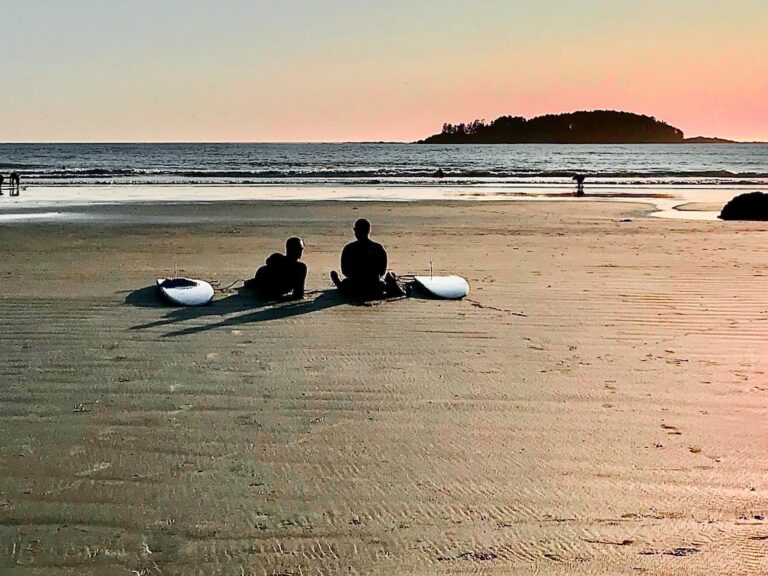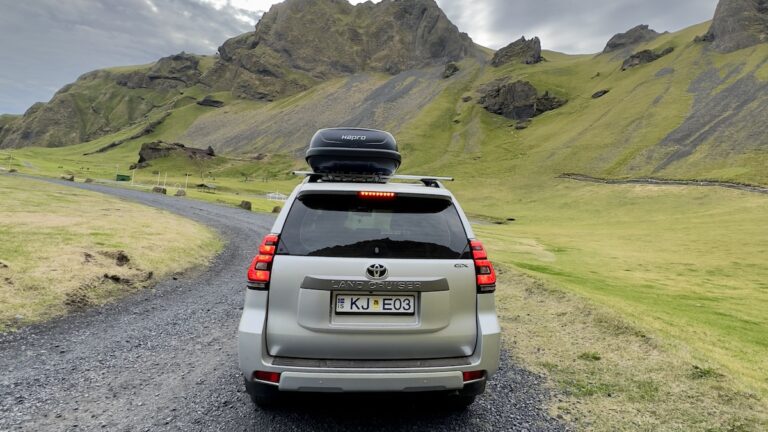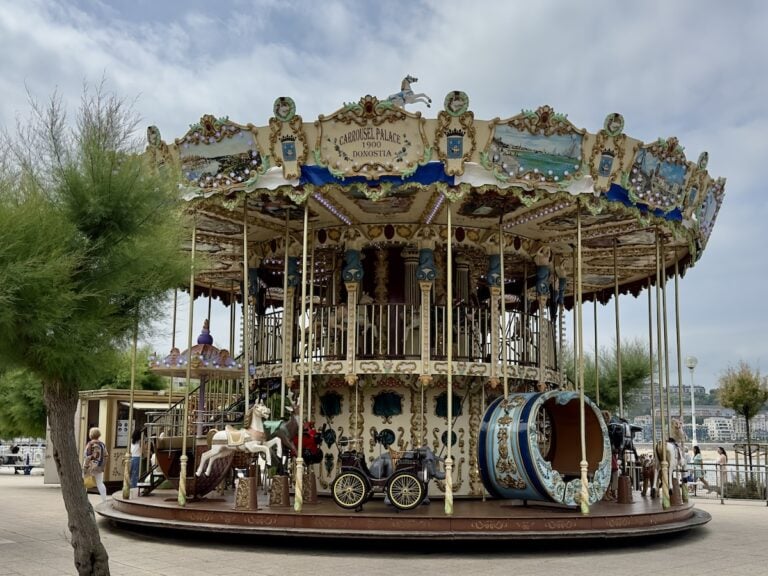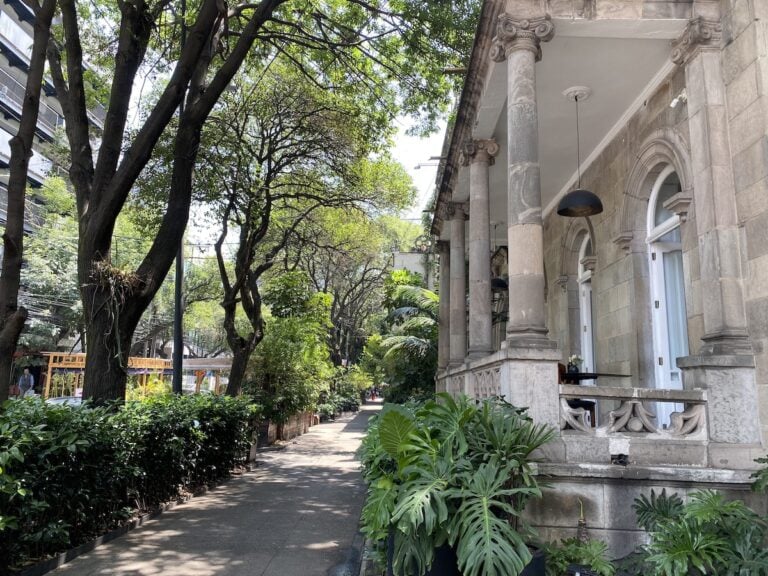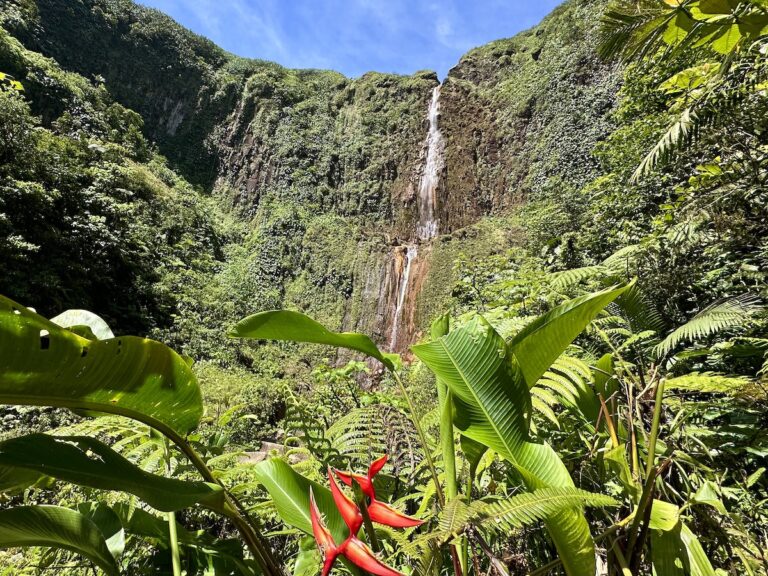The Top Things to See in Seville, Spain (2025)
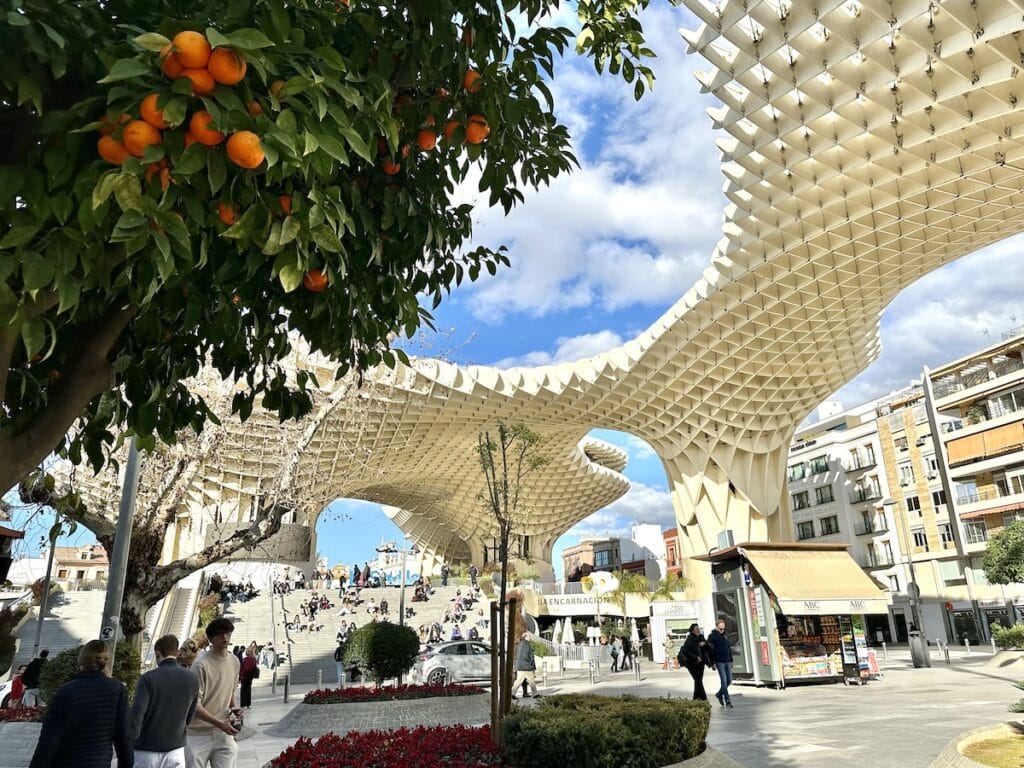
Affiliate Disclosure: This post on the Top Things to See in Seville, Spain contains affiliate links. If you click on a link and make a purchase, I may receive a small commission at no cost to you.

HI, I’M TARA!
I love sharing hidden gems far from the crowds, unique boutique hotels, and unforgettable wildlife adventures – helping you have extraordinary travel experiences.
INTRODUCTION
As our taxi wound through Seville’s narrow streets, I couldn’t help but wonder—how had I never visited this stunning Andalusian city before? The grand architecture, the maze of charming lanes lined with orange trees, the lively plazas… it was simply magical.
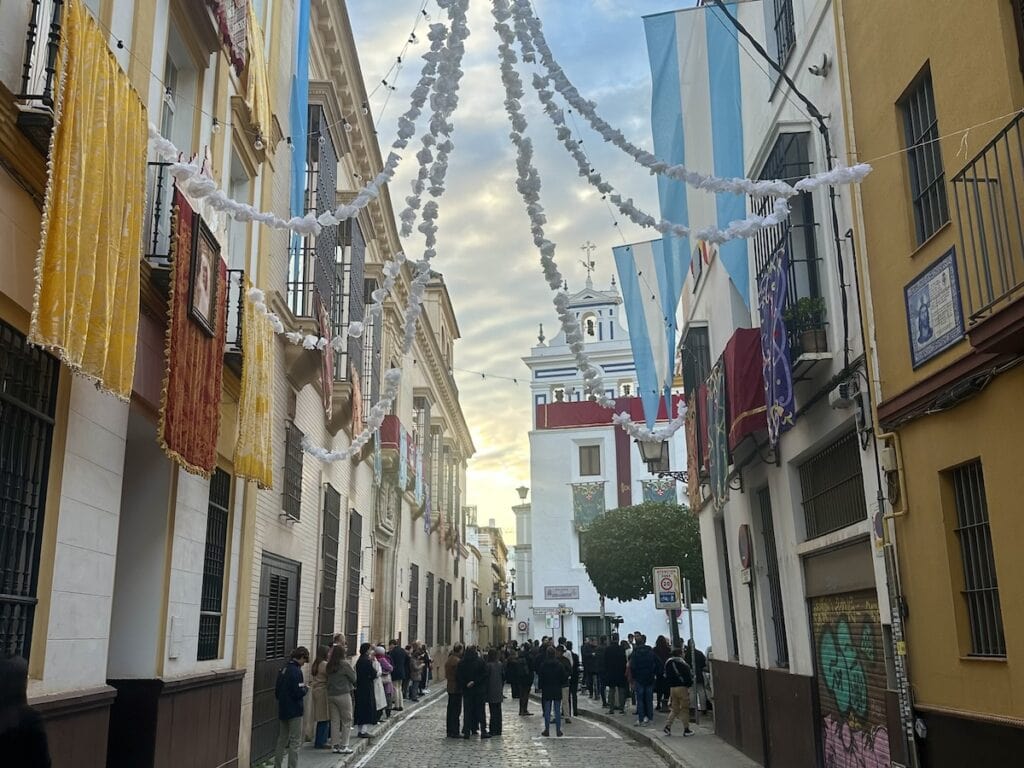
But any sense of having missed out quickly faded as I began to explore. Seville (Sevilla in Spanish) more than lives up to the hype. Even better, unlike larger Spanish cities like Barcelona or Madrid, its compact size makes it incredibly easy to explore on foot in just two or three days—though you’ll likely find yourself wishing for more time. Seville is a city best savored, not rushed.
In this post, I’ll share everything you need to know to uncover the best things to see in Seville, Spain—from awe-inspiring landmarks to unique things to do in Seville that make this city so special.
But first, a little introduction to this incredible city, with a 90-second highlights video to offer you a glimpse of what makes Seville so special.
SEVILLE VIDEO (90 SEC.)
WHY VISIT SEVILLE?
Seville, Spain, is a city that captivates with its stunning architecture, from the intricate Moorish designs of the Alcázar Real to the grandeur of the Gothic cathedral and the striking Metropol Parasol. Whether you’re spending 2 days in Seville, Spain or planning a longer itinerary, the city’s rich history and vibrant culture make every moment unforgettable.
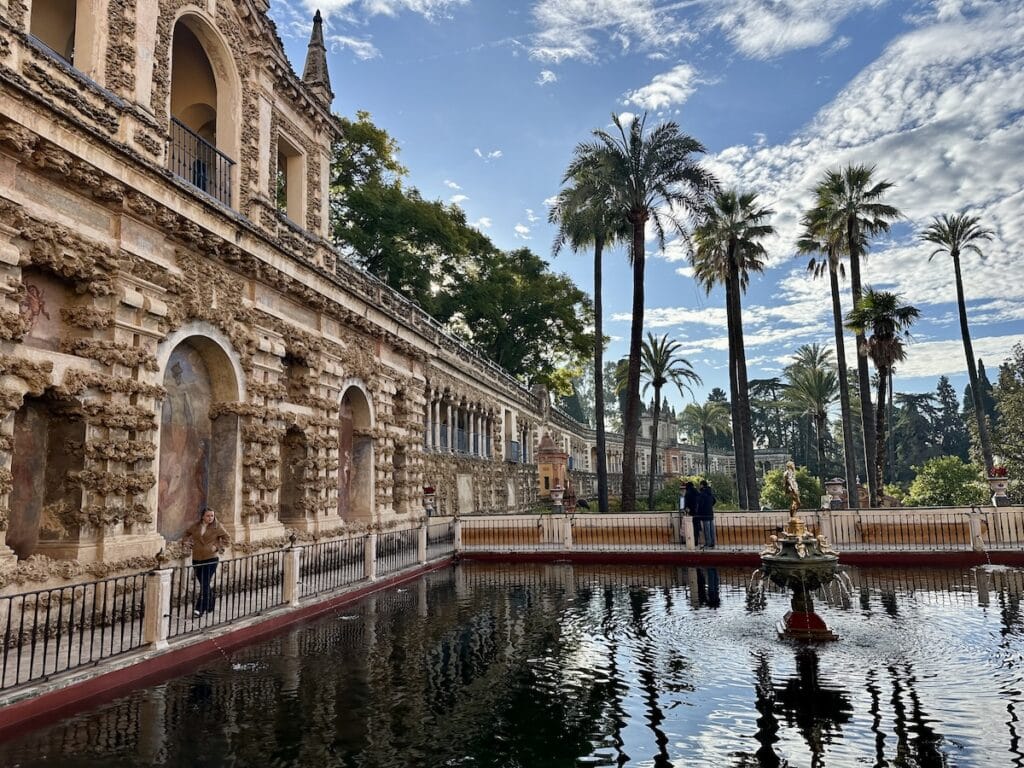
As the gateway to the Americas during Spain’s Golden Age, Seville flourished as a center of wealth and exploration—an era that shaped its lively streets, passionate flamenco culture, and grand religious festivals. Today, the city’s countless orange trees fill its plazas and narrow lanes with their fragrant blossoms in spring and vibrant fruit in winter, adding to its timeless charm.
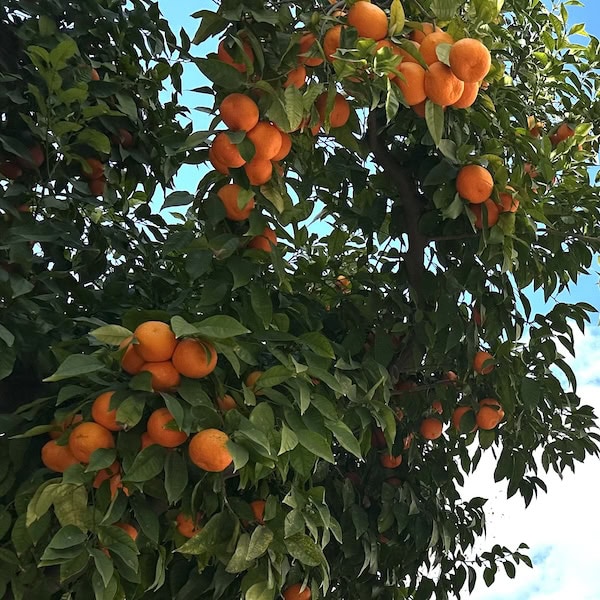
SEVILLE’S ICONIC ORANGES
Seville is famous for its bitter orange trees, which line the city’s streets. Though too tart to eat fresh, these oranges are prized for making marmalade, liqueurs, and even perfumes. There are more than 40,000 orange trees in Seville!
QUICK TIPS FOR VISITING SEVILLE
BEST TIME TO VISIT
Spring (March–May) and fall (September–November) offer pleasant weather and major cultural events like Semana Santa (March or April), the Feria de Sevilla (April or May), and the Bienal de Flamenco (September in even-numbered years).
Planning a winter trip? There are plenty of things to do in Seville in November through February, from exploring its stunning landmarks without the summer crowds to enjoying seasonal treats like churros con chocolate.
Summer can be extremely hot and is considered the least favorable time to visit. In July and August, daily highs can exceed 40°C (104°F). If visiting during this time, plan sightseeing for early mornings and evenings to avoid the midday heat.
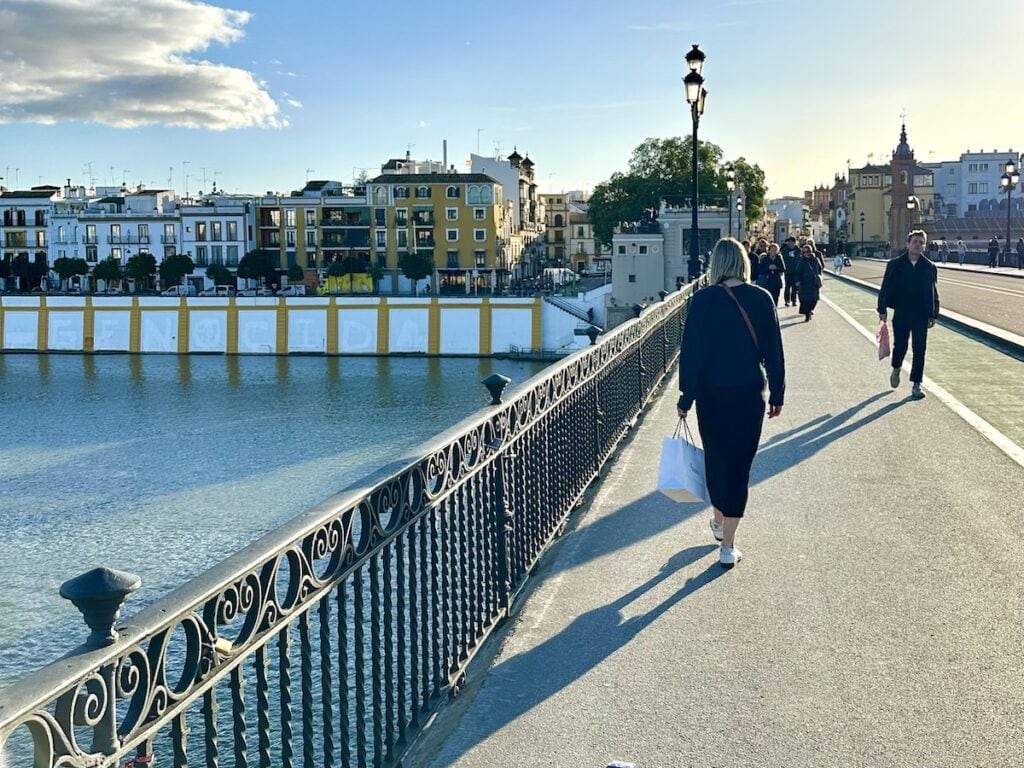
NOTE: We visited Seville in February. Although cool at night (definitely jacket weather), the days were quite lovely, with temperatures ranging from 12–20°C (53–70°F).
BOOK TICKETS IN ADVANCE
Seville’s most popular sights, like the Real Alcázar and Seville Cathedral, often sell out, especially in peak seasons. Booking online in advance—several weeks ahead if visiting in spring or early autumn—ensures entry and helps avoid long lines. Guided tours can also offer priority access and deeper insights into the city’s history.
TIP: Make sure you are booking your tickets directly from official sites, as some websites appear official but are actually tour companies charging higher prices. (I’ve linked official sites for the major attractions below.)
PLAN TO EXPLORE BY FOOT
With its compact size and maze of streets, Seville is best explored on foot. That said, its cobblestone streets can be tough on your feet. Comfortable walking shoes are essential for navigating the uneven surfaces.
If you get tired, taxis are a convenient way to get around. Personally, I’d never want to navigate Seville’s narrow streets in a rental car. Taxi drivers, however, seem to know the dimensions of their vehicles to the millimeter! (I saw more than one stressed-looking tourist scraping paint off the side of their rental while trying to squeeze through the tight streets!)
NOTE: Uber also operates in Seville, but we found the taxi service to be excellent, so we primarily used taxis, including for trips to and from the train station
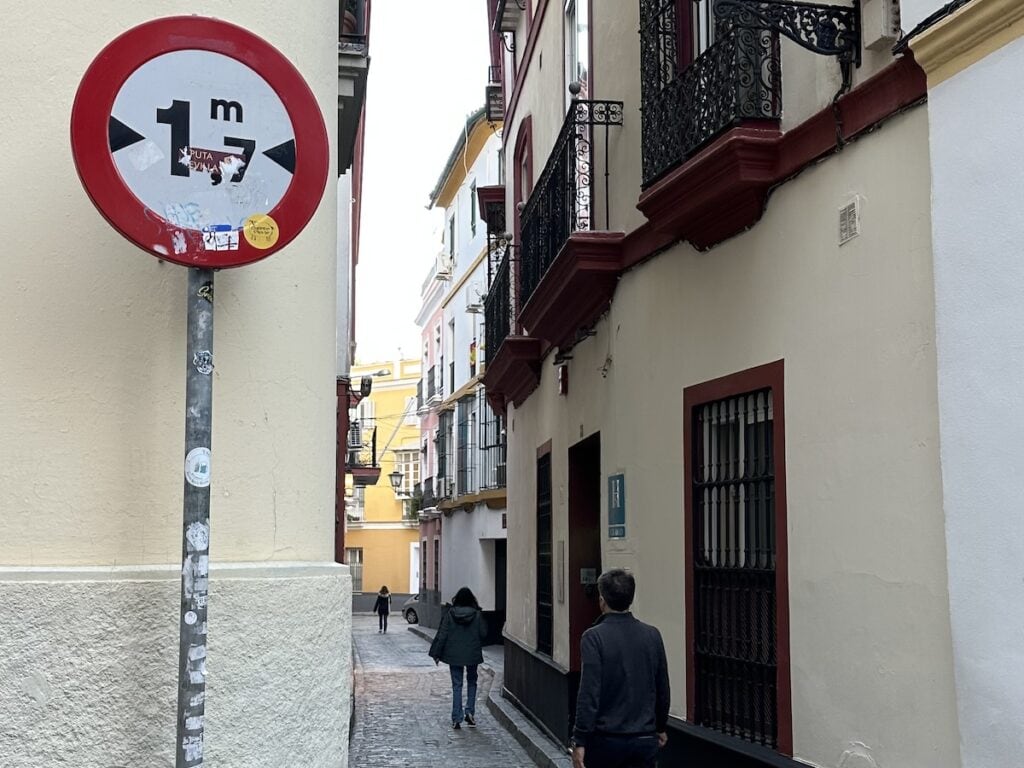
ADJUST TO THE LOCAL SCHEDULE
As in the rest of Spain, lunch is late (2:00–3:00 PM), and dinner starts around 9:00–10:00 PM. Many shops and businesses close from 2:00 to 5:00 PM for siesta, so plan your days accordingly.
EAT TAPAS
For an authentic taste of Seville, skip the tourist menus and embrace the local tapas culture—order a few small plates at one bar, then move on to the next, sampling the local specialties like salmorejo, jamón ibérico, and espinacas con garbanzos along the way. Whether you have 1 day, or 5 days in Seville, a tapas crawl is an essential experience!
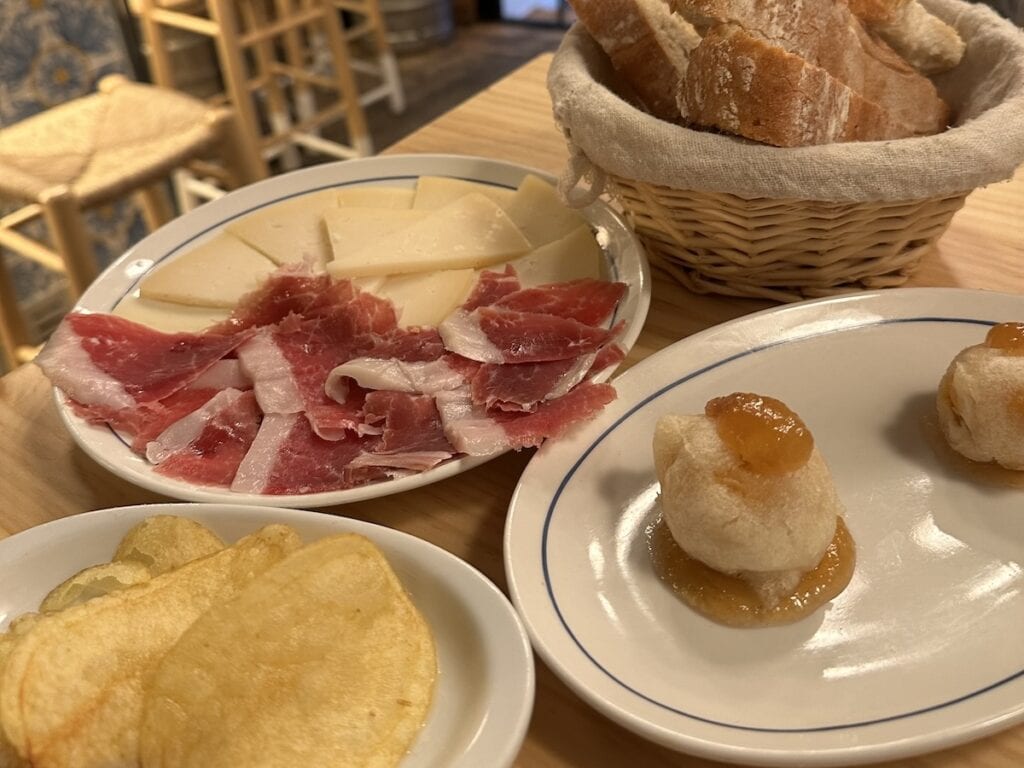
TIP: If you’ve never experienced tapas in Spain before, it can feel a bit intimidating, especially if you don’t speak Spanish. One of the best tours we’ve ever done in Spain was a tapas tour in San Sebastián (or “pintxos,” as these tasty bites are called in the Basque region). Not only did we get a history tour and an incredible meal, but we also gained the confidence to navigate tapas bars on our own in the following days.
See these top rated Seville tapas tour options with Viator.com:
Alternatively, I found this to be a very helpful guide to navigating tapas bars in Seville from Where and Wander: Sevilla Must Eats and Best Tapas Bars.
HOW MANY DAYS SHOULD YOU SPEND IN SEVILLE?
Many travelers wonder how much time to dedicate to Seville. While it’s possible to enjoy the top things to see in Seville, Spain in 2 days, a 3-day Seville itinerary allows for a more relaxed experience.
- If you’re short on time, a 2-day Seville itinerary covers the major landmarks.
- For a deeper dive, a 3-day itinerary in Seville lets you explore at a comfortable pace.
- If you love slow travel, consider 4 days in Seville or even a 5-day Seville itinerary. This would also also allow you to use Seville as a base to do some incredible day trips (ex. Ronda and the Alhambra).
No matter how long you stay, Seville’s charm will leave you wanting more. (It certainly did for me!)
BEST THINGS TO DO IN SEVILLE
1. JOIN A WALKING TOUR
While my husband and I typically like to explore on our own, Seville has such a rich and fascinating history that I think it is absolutely worth doing a short walking tour at the beginning of your stay. After that, you can take your time returning to all the places that piqued your interest.
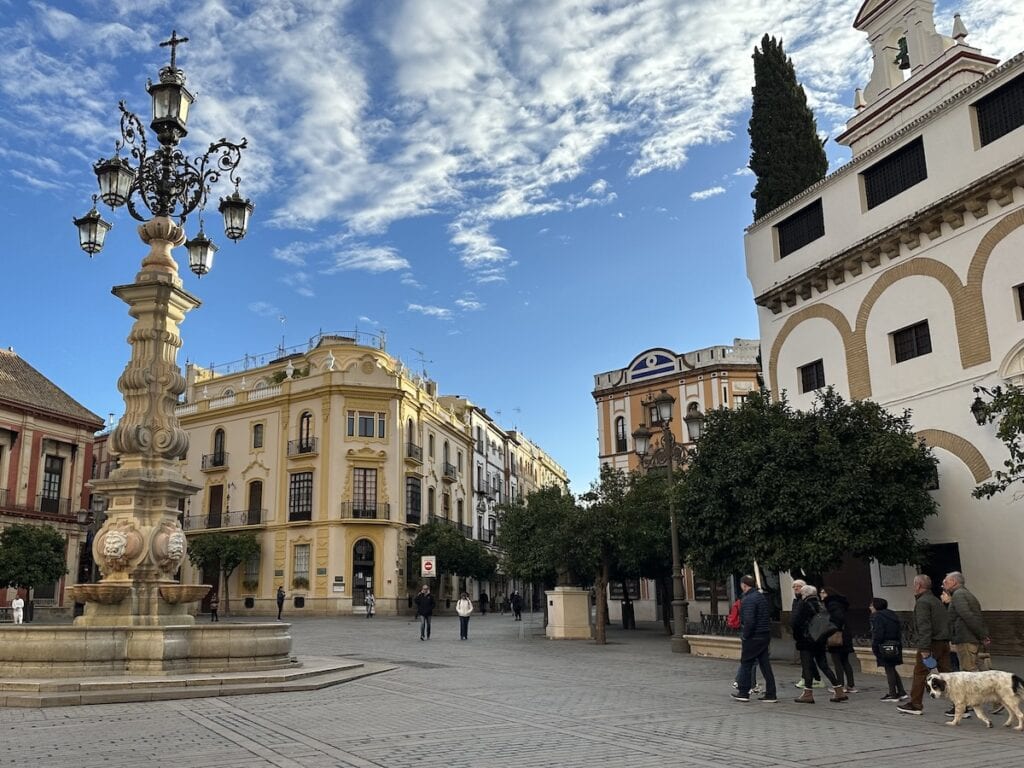
Walking through its charming neighborhoods, hidden courtyards, and bustling plazas, visitors experience a living history that makes Seville one of the most captivating and culturally rich destinations in Spain.
There are tons of different options available, but here are a few I really like:
- SELF GUIDED TOUR APP – See the Rick Steves’ Seville 90 Min. Audio Guide (free). My teens love to joke that Rick Steves is for old people. I don’t disagree (my parents, in their late 70s, are massive fans), but he really does such a great job! For alternatives, see options with VoiceMap and GPS my City.
- SMALL GROUP TOURS – If you decide to do a group tour of Seville, I highly recommend choosing a small group. Having just been in Seville with a large group for a significant birthday, I can tell you that getting around with several dozen people is like herding cats! See this 2hr Small Group Waking Tour of Seville from Get Your Guide.
- PRIVATE TOURS – If you prefer a private, more in-depth tour, I’m a big fan of the company Context Walks. Their 3-hour, private Introduction to Seville tour gets rave reviews.
2. EXPLORE THE REAL ALCÁZAR
The Real Alcázar is a stunning palace complex that has evolved over centuries, showcasing a blend of Mudéjar, Gothic, Renaissance, and Baroque architecture. Originally built by the Moors in the 10th century, it later became the residence of Christian monarchs and continues to be used by Spanish royalty today.
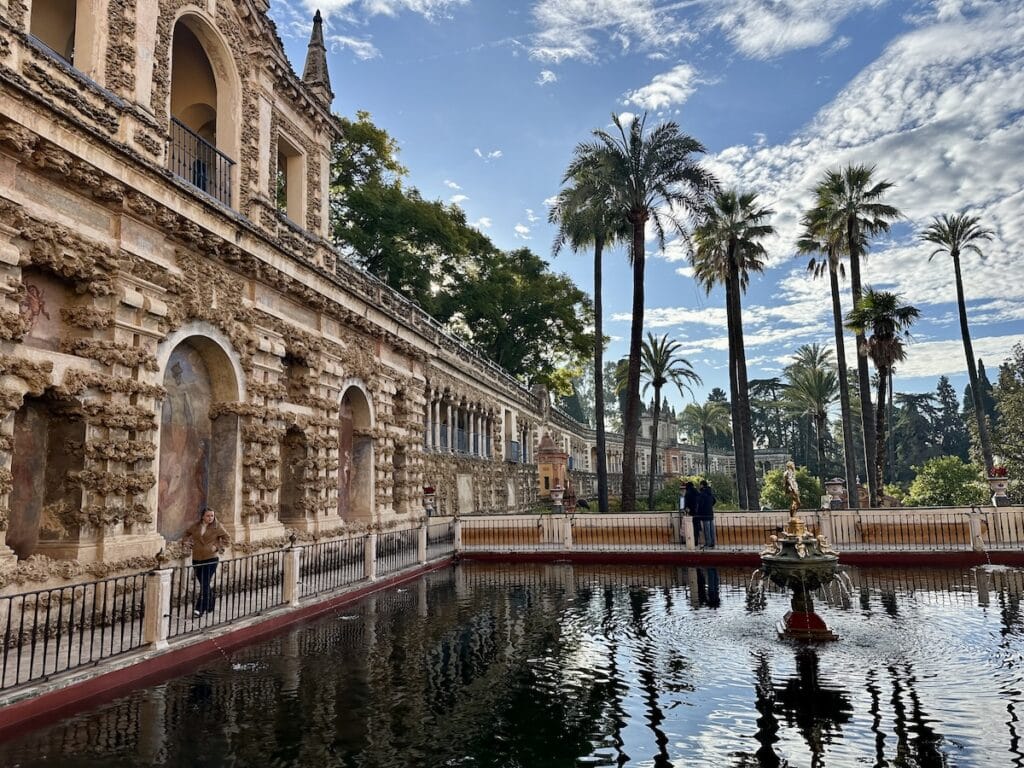
This is city’s top attraction, and it’s an absolute must-see, whether you have 1 day in Seville or 3 days in Seville. To fully appreciate its intricate tilework, grand halls, and breathtaking gardens, advance planning is essential —tickets sell out quickly, especially in high season (March-June, Sept-October). We visited on a February morning (low season) just after opening and the first two time slots had already booked up.
Tickets can be booked online in advance. On the site there is a QR code for a downloadable audioguide and PDF map. See tickets here.
TICKETS SOLD OUT?
If you cannot find an available time slot for your visit, consider joining a group tour with guaranteed entry.
See these top rated tour options with Viator.com:
NOTE: An alternative option if tickets to the Real Alcázar are completely unavailable, is to visit the Palacio de las Dueñas, located approximately a 20-minute walk from the Alcázar. Built between the 15th and 16th centuries, this palace blends Gothic-Mudéjar and Renaissance styles and houses a significant art collection. See tickets here.
3. VISIT SEVILLE CATHEDRAL & LA GIRALDA
Seville Cathedral is the largest Gothic cathedral in the world and houses the tomb of Christopher Columbus. Built on the site of a former mosque, it boasts impressive altars, towering ceilings, and stunning stained-glass windows.
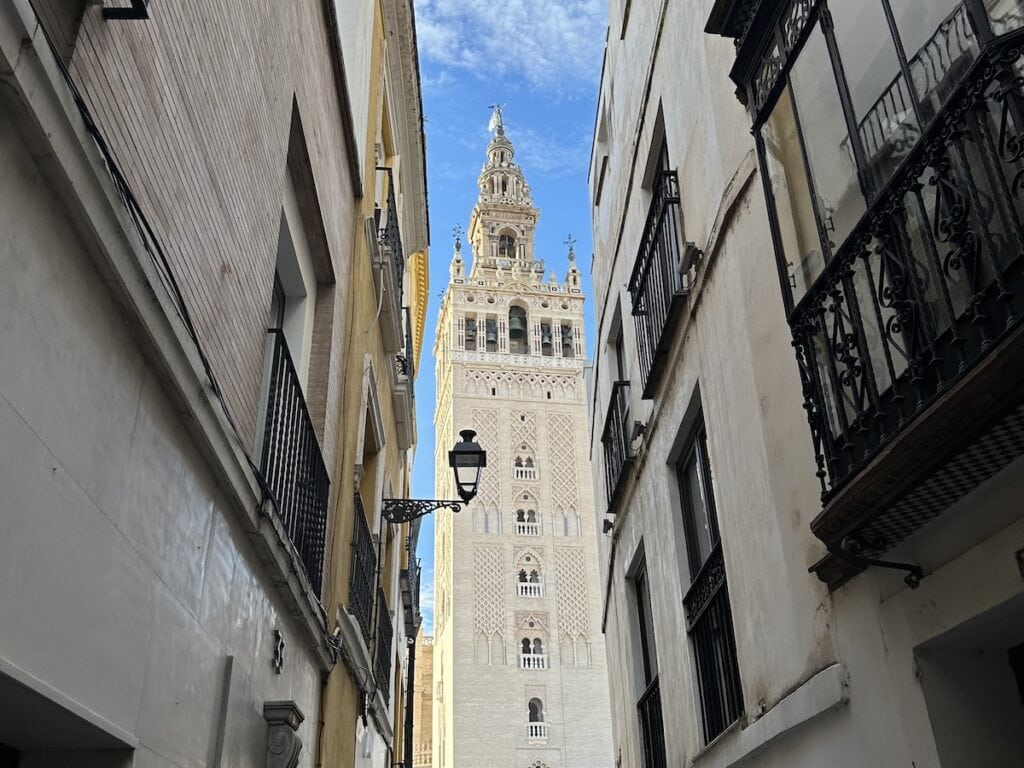
As part of your visit you can climb La Giralda, one of Seville’s most iconic landmarks. Originally a 12th-century minaret, it was later converted into a bell tower. The unique ramp-style ascent makes it easier to climb than stairs, and the view from the top over the rooftops of Sevilla is beautiful!
The cathedral and the Alcázar Real are located right beside each other and many people do these two attractions back-to-back. Tickets should be booked in advance online so as not to be disappointed. See tickets for Sevilla Cathedral here.
If you are having a hard time finding tickets, a guided tour is always an option.
4. ARCHIVO GENERAL DE INDIAS
This UNESCO World Heritage site is a must-visit for history lovers, housing a vast collection of original documents, maps, and letters from Spain’s colonial era, including records linked to explorers like Columbus and Cortés. While primarily a research facility, its most valuable records aren’t always on display but occasionally appear in its rotating exhibitions.
Archivo General de Indias is set in a 16th-century Renaissance building, (originally the Merchants’ Exchange) and is worth visiting for the architecture alone. Better yet? Entry is free, a visit takes less than an hour, and the building is nice and cool inside, making it a wonderful retreat on a hot Seville day!
To learn more of for hours of operation, click here. Many city walking tours also include the Archivo General de Indias. (See options on Viator.)
5. WANDER THE STREETS OF SANTA CRUZ
The Barrio de Santa Cruz, Seville’s former Jewish Quarter, is a historic neighborhood characterized by its narrow, winding streets, whitewashed houses, and charming plazas. It’s one of the romantic things to do in Seville, especially in the evening.
Located adjacent to the Alcázar Real, this area was home to a thriving Jewish community between the 13th and 15th centuries. Following the expulsion of Jews from Spain in 1492, the quarter experienced periods of neglect until its restoration in the 20th century. Today, Santa Cruz is one of Seville’s most picturesque and visited districts, offering a glimpse into the city’s diverse cultural past.
6. STROLL THROUGH PLAZA ESPAÑA & MARÍA LUIS PARK
Plaza de España is one of Seville’s most beautiful spots, built for the 1929 Ibero-American Exhibition, a world fair celebrating Spain’s ties with Latin America.
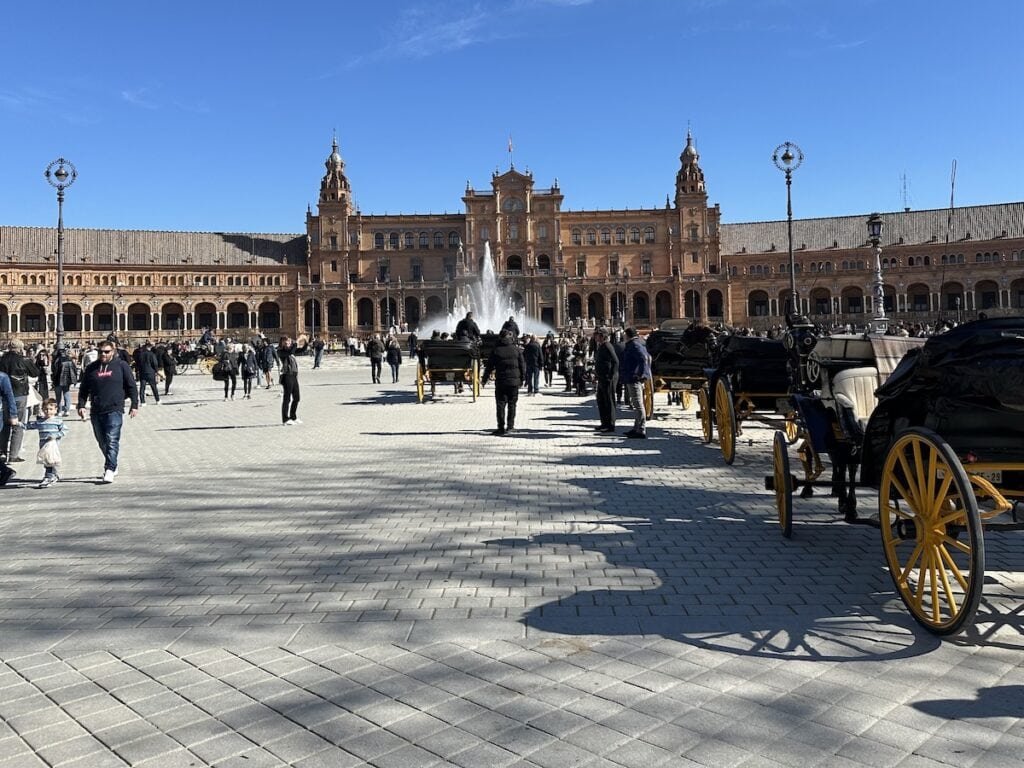
The plaza blends Renaissance, Moorish, and Art Deco styles, with stunning tilework, elegant bridges, and a canal where you can rent rowboats. Its 52 colorful ceramic benches showcase different Spanish provinces, making it both a visual and cultural landmark.
Located inside the lush María Luisa Park, it’s the perfect place for a relaxed stroll, picnic or a scenic break from sightseeing. If you’re on a tighter budget, this is also one of the best free things to do in Seville, Spain.
NOTE: You’ll see plenty of tourists taking horse carriage rides in Seville, especially around Plaza de España. Personally, this is not something I am comfortable recommending—especially in the summer heat, which creates tough conditions for the horses. The city has added shaded waiting areas to improve their welfare, but change may be coming. In fact, the Spanish city of Malaga announced a ban on horse-drawn carriages in early 2025.
7. STROLL THE GUADALQUIVIR RIVER
Take a leisurely stroll along the Guadalquivir River between Puente de San Telmo and Puente de Isabel II (a.k.a. Triana Bridge) for some of Seville’s best views, where historic landmarks, vibrant neighborhoods, and scenic riverfront paths come together.
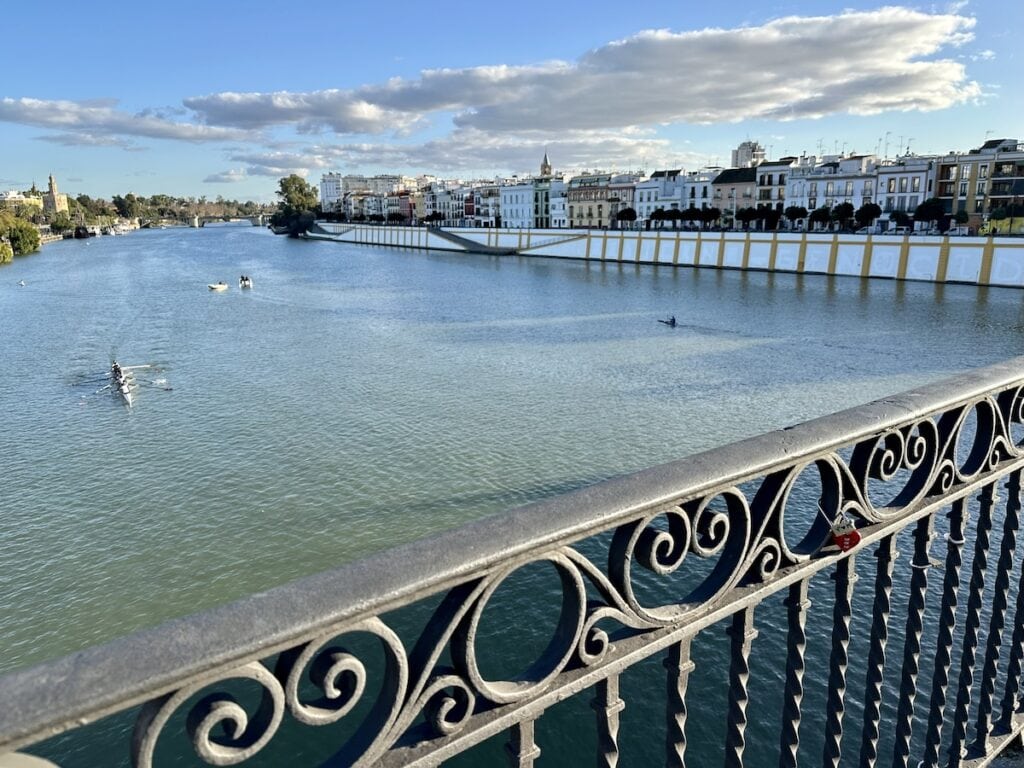
Along the way you will pass by the 12-sided Torre del Oro (Tower of Gold), a 13th-century watchtower that once protected the city and now houses a maritime museum.
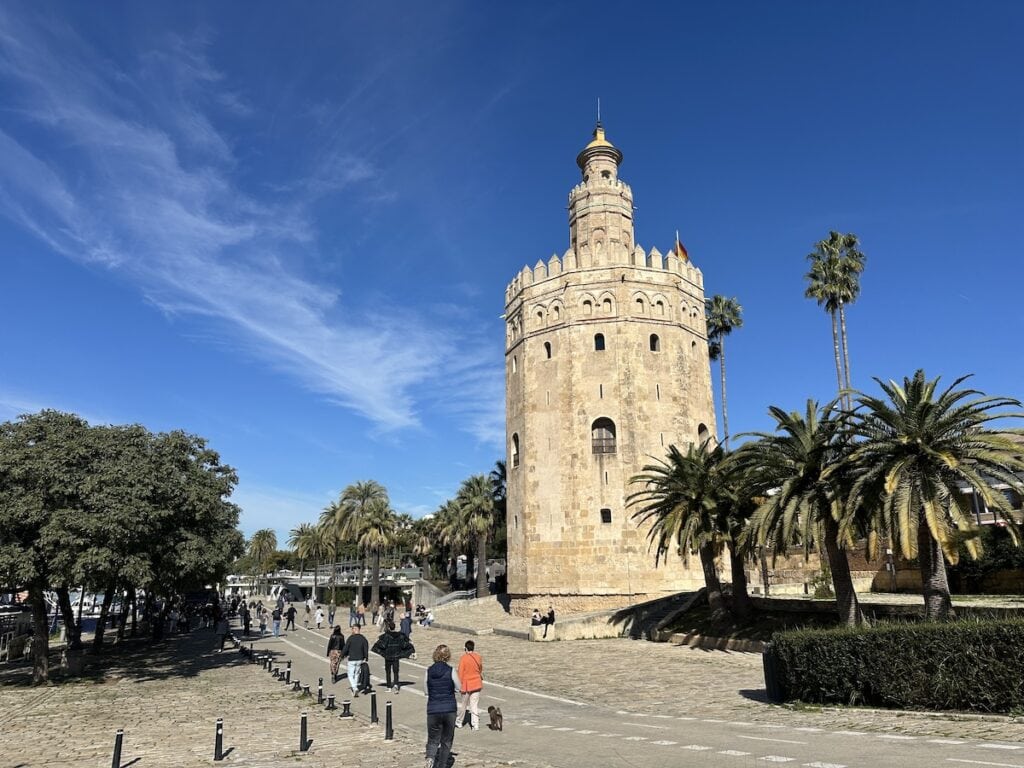
If you are feeling peckish, pop into the new Mercado del Barranco – a gourmet food market and entertainment space located right at the base of Puente de Isabel II. It’s a lovely venue for a cocktail, tapas, or both!
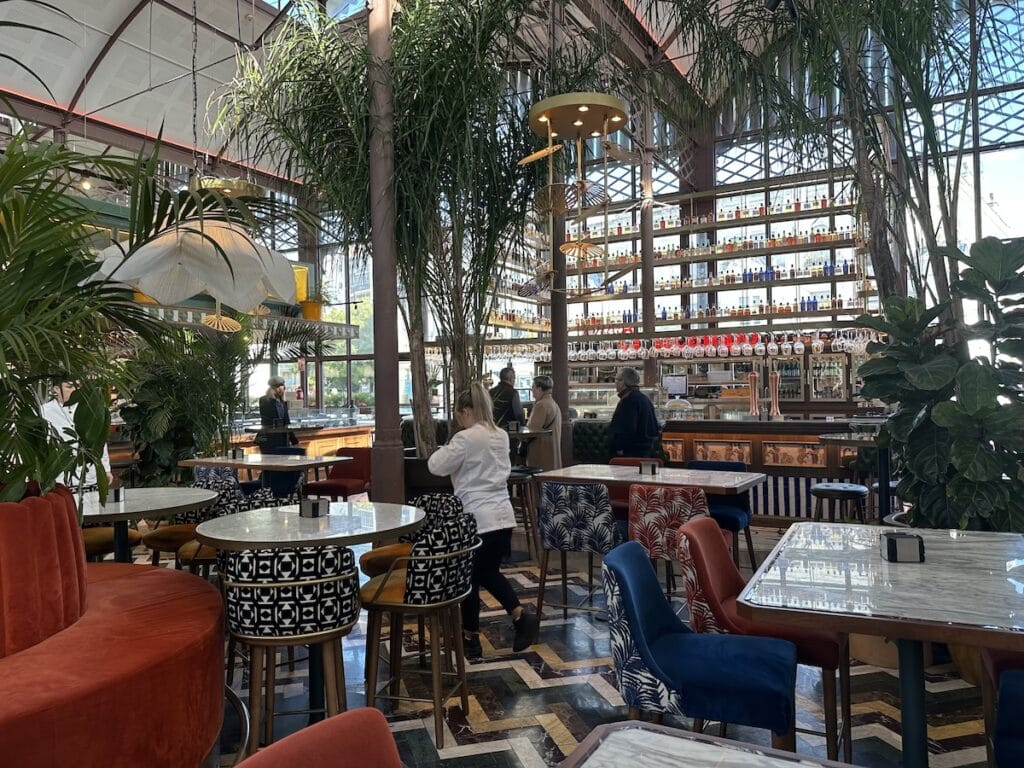
NOTE: While this market is quite gorgeous, it may feel overly curated to some. If you seek a more authentic, locals’ market…read on about Triana, just across the river.
If you would like to actually spend some time on the river, here are a couple of options with Viator.com:
8. EXPLORE TRIANA
Cross over Puente de Isabel II and you’ll find yourself in Triana, a neighborhood with a personality all its own. As you make your way across the bridge, take a moment to admire the colorful houses lining Calle Betis, which runs along the river and is especially beautiful at sunset.
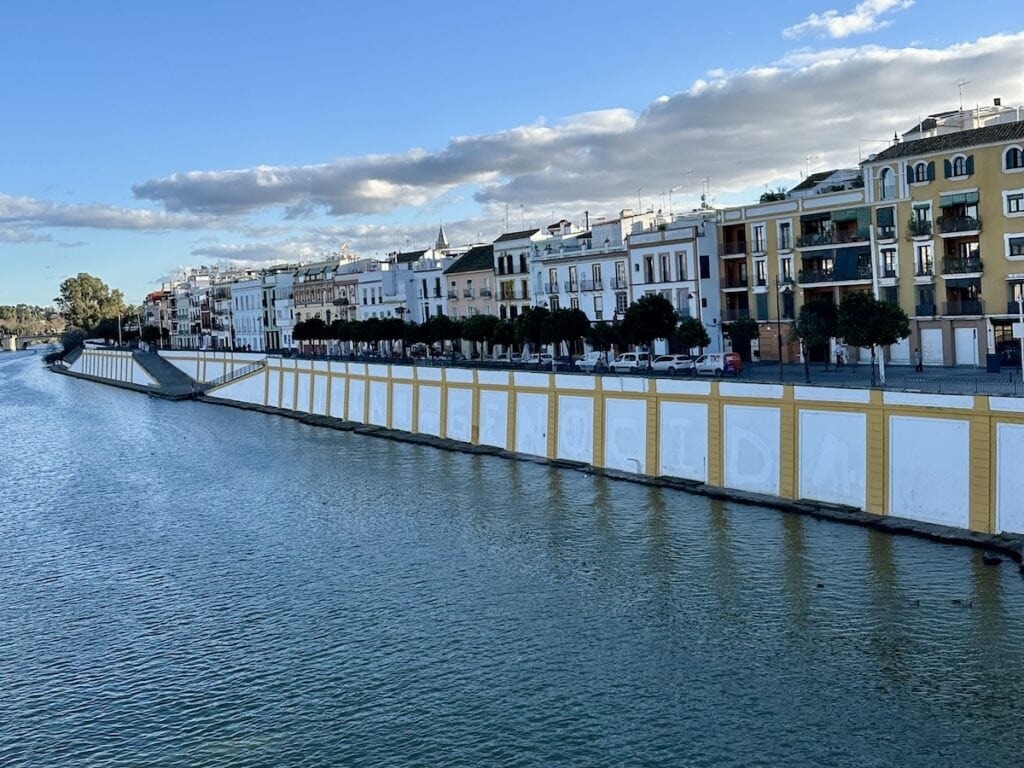
Once in Triana, stop by the Triana Market, a lively spot where locals shop for fresh produce, meats, and seafood. The market is a great place to grab a casual tapas lunch, with plenty of stalls serving up Andalusian favorites. (There are also plenty of other great tapas restaurants in the neighborhood.
See these top rated Triana Market tour options with Viator.com:
After eating, explore the ceramic shops along Calle Alfarería, where hand-painted tiles have been a part of Triana’s heritage for centuries. In the evening, this neighborhood comes alive with the sounds of flamenco—Triana is considered the birthplace of the art form, making it one of the best places in Seville to experience an intimate, authentic performance.
9. EXPERIENCE A FLAMENCO SHOW
Seville is the birthplace of flamenco, and there’s no better place to experience this passionate dance. Attending a live performance is an unforgettable experience, and a must if you’re looking for fun things to do in Seville at night.
Venues like Teatro Flamenco Triana, Casa de la Memoria and the Museo del Baile Flamenco offer performances that showcase the raw emotion, skillful footwork, and soulful singing that define this art form.
Many flamenco venues offer dinner and show packages, but your experience need not be that formal. At some smaller venues, there is no entry fee, just an expectation that you purchase drinks and/or tapas. Please be aware, however, that some of the smaller places are cash only.
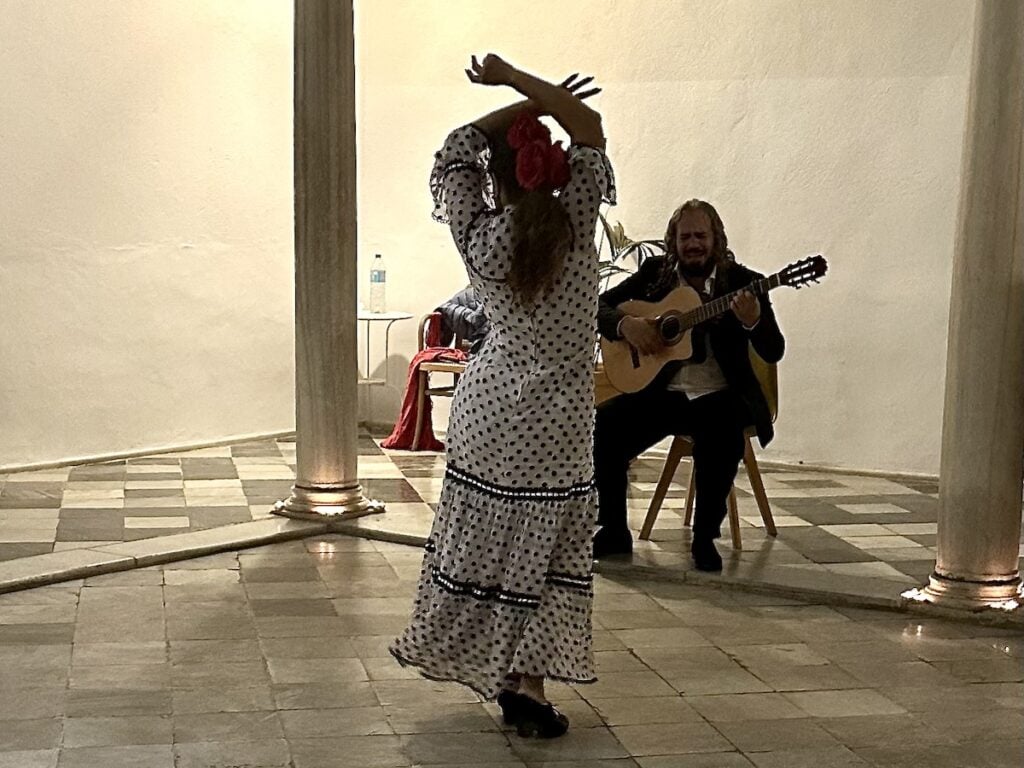
If you are looking for a smaller, more intimate venue, I really loved the recommendations in this BBC article: A dancer’s guide to Seville’s best flamenco experience.
See also these top rated flamenco show options on Viator.com:
10. DISCOVER LAS SETAS
Nicknamed Las Setas (“The Mushrooms”) but officially called Metropol Parasol, this striking architectural landmark offers one of the best panoramic views of Seville from its rooftop. It’s one of the more unusual things to do in Seville and a great stop if you’re spending 2 days in Seville or more. (It may be slightly out of your way, otherwise.)

The plaza at Las Setas is lively at any time of day. My husband and I found ourselves there for early morning coffee, afternoon tapas, and even late at night (or was it early morning?) dancing at a cocktail bar with friends!
Beneath the plaza, you’ll find an intriguing archaeological museum, created when Roman ruins were uncovered during construction.
11. GO SHOPPING
The city’s main shopping area is centered around Calle Sierpes and Calle Tetuán, two bustling pedestrian streets lined with a mix of international brands and local boutiques.
If you’re seeking a modern shopping environment, Nervión Plaza is a contemporary mall featuring a wide array of stores and entertainment options. Additionally, the area around Las Setas has evolved into a trendy shopping district known as Soho Benita, offering unique boutiques and artisanal shops.
WHAT SHOULD YOU BUY IN SEVILLE?
- CERAMIC TILES (AZULEJOS): Seville is renowned for its intricate ceramic tiles, known as azulejos. These colorful, hand-painted pieces make for beautiful decorative souvenirs. The Triana neighborhood, in particular, is famous for its ceramic workshops.
- OLIVE OIL: Spain is one of the world’s leading producers of olive oil, and the Andalusian region, where Seville is located, is particularly famous for its high-quality extra virgin olive oils. Bringing home a bottle allows you to savor the authentic flavors of Andalusian cuisine.
- ORANGE PRODUCTS: Seville’s iconic orange trees yield a variety of products that capture the city’s distinctive fragrance and flavors. Beyond orange blossom perfumes, consider bringing home Seville orange marmalade, cherished for its unique bitter-sweet taste, or vino de naranja, a sweet wine macerated with orange peel.
- LEATHER GOODS: Spain has a long-standing tradition of leather craftsmanship. In Seville, you’ll find a variety of high-quality leather products, including handbags, belts, and shoes, reflecting both traditional designs and contemporary styles.
- ESPADRILLES: Espadrilles are traditional Spanish footwear featuring canvas uppers and esparto rope soles. In Seville, you can find handcrafted espadrilles that blend comfort with cultural heritage. For a unique experience, consider participating in a workshop where you can stitch your own pair under the guidance of local artisans.
NOTE: While the name may not translate intuitively for English speakers, ladies, I highly recommend a visit to Flabelus for their beautiful handmade ballet flat-style espadrilles. These shoes are made by talented Spanish artisans, combining the essence of traditional espadrilles with a modern twist.
Here are mine. Do I know where I’ll wear them? Not at all—but I sure love looking at them and don’t regret the purchase one bit!
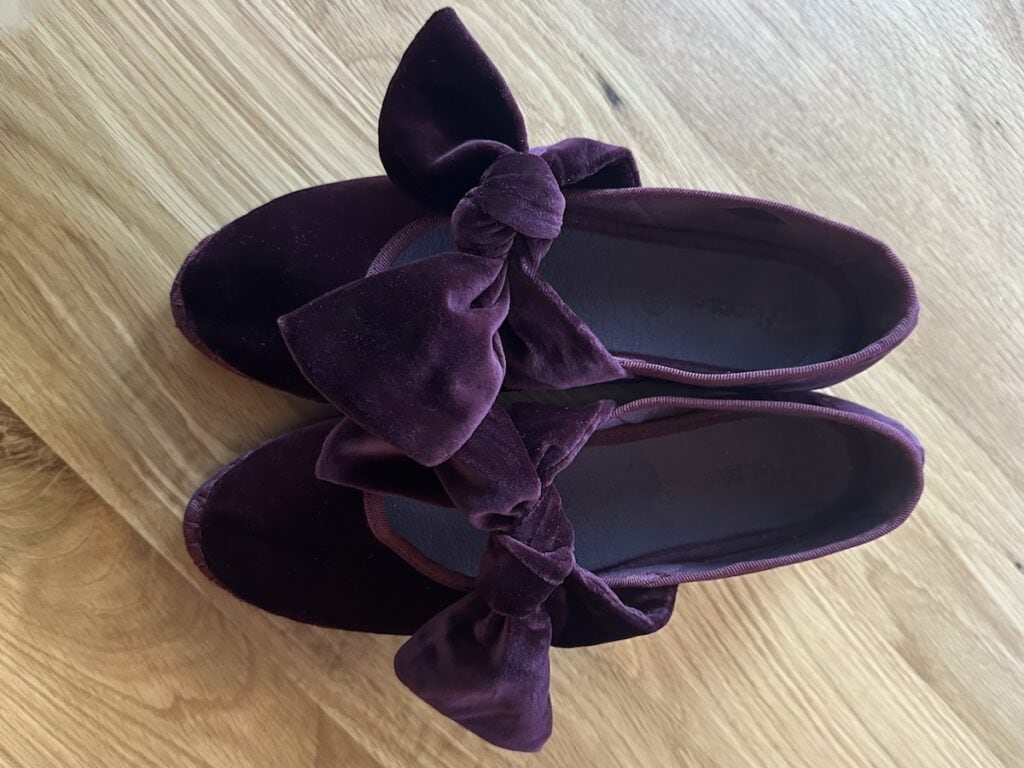
12. TAKE A DAY TRIP
Seville serves as an excellent base for exploring Andalusia’s rich cultural heritage. Top day trips include visits to the UNESCO-listed city of Granada and the stunning Alhambra; a tour of Spain’s picturesque white villages, including Ronda, known for its dramatic El Tajo Gorge and historic bullring; Cádiz, one of Europe’s oldest cities, featuring Roman ruins and beautiful beaches; Jerez de la Frontera, famous for its sherry and equestrian traditions; and even a journey to Tangier, Morocco!
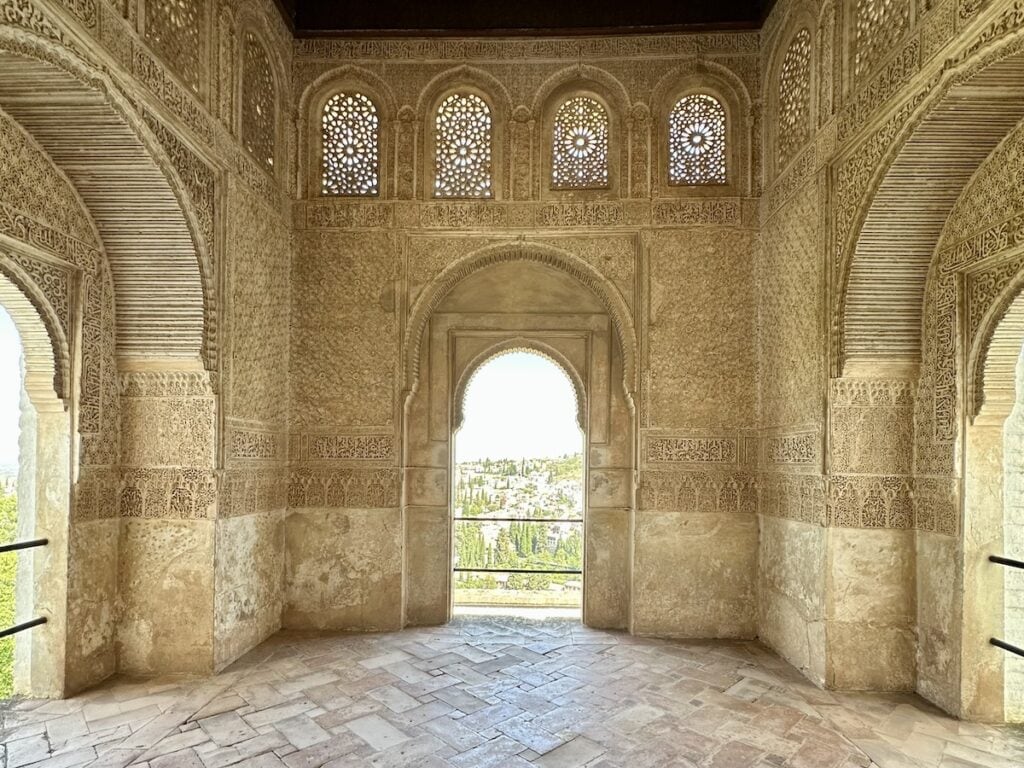
See these top rated day tours with Viator.com:
- Ronda and White Villages Small Group Tour
- Luxury Private Tour to Granada and the Alhambra
- Luxury Private Tour to Tangiers, Morocco
SEVILLE ATTRACTIONS MAP
I’ve plotted all of the most important Seville attractions on the following Google map. For an interactive version, please use this link or click on the image below.
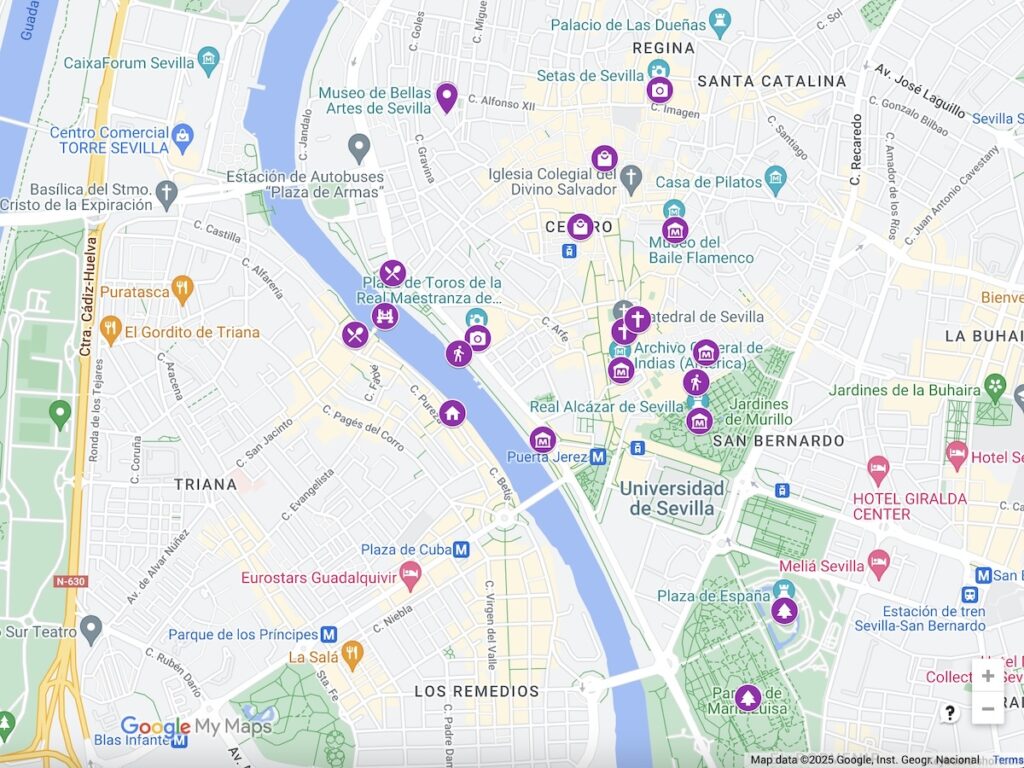
GETTING TO SEVILLE
Seville is well-connected to major cities in Spain and Europe, making it accessible by various modes of transportation. The San Pablo Airport (SVQ), located about 10 kilometers northeast of the city center, offers flights from all major cites in Spain as well as dozens of other European cities. Upon arrival, travelers can reach the city center in approximately 15 minutes by taxi or 35 minutes by bus.
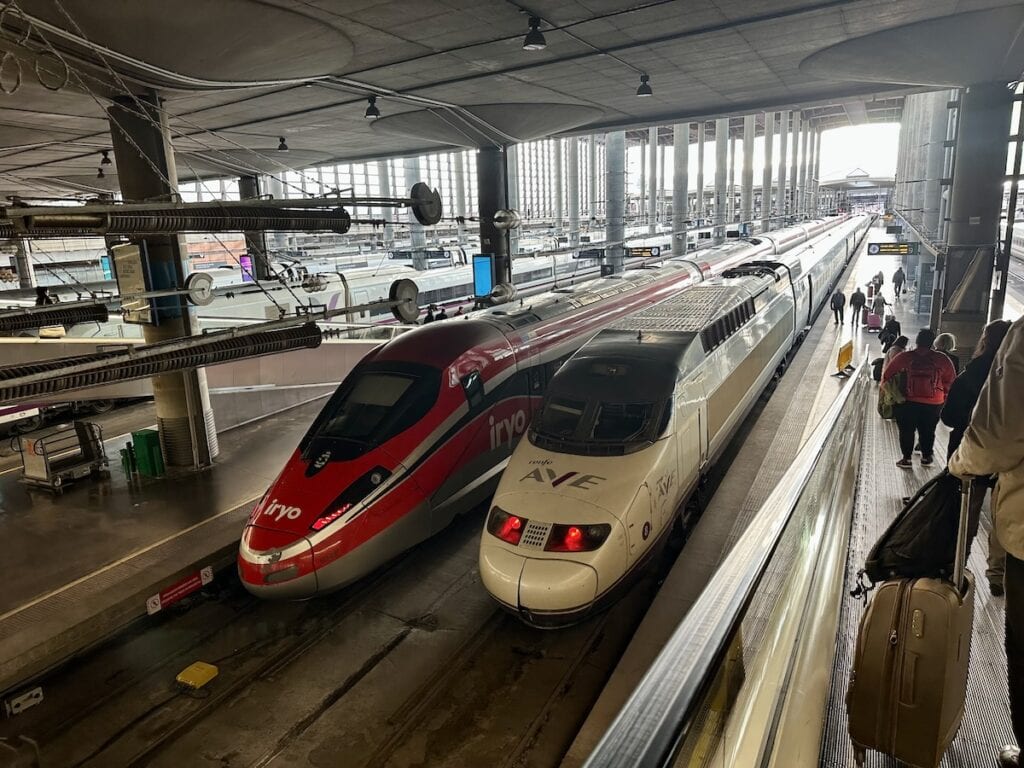
For those traveling by train, Seville-Santa Justa Railway Station is a major hub served by Spain’s high-speed AVE trains, providing rapid connections from cities like Madrid, Barcelona, and Valencia. For example, the AVE journey from Madrid to Seville takes just over 2.5 hours.
Additionally, Seville is accessible by bus, with services connecting it to various Spanish cities and neighboring countries. The city’s two main bus stations, Plaza de Armas and Prado de San Sebastián, handle routes from different regions.
WHERE TO STAY IN SEVILLE
This turned out to be quite a big topic for me. I have created a separate guide to the best boutique hotels in Seville. Even if boutique hotels are not your style, the post offers a bunch of other useful information about booking accommodations in Seville that should be helpful to you.
FINAL THOUGHTS
Seville is a city that blends history, culture, and modern vibrancy, making it an unforgettable destination. Whether you have 3 days in Seville, Spain or a week, I hope this guide will help you make the most of your trip.
If you’re planning a trip and need more details, let me know in the comments! And if you’ve already visited Seville, I’d love to hear your favorite experiences. Alternatively, feel free to reach out to me via direct message on Instagram, Facebook or by email.
Want to see more unique adventures? I would love for you to follow along with The Better Beyond on Instagram!
FURTHER READING
- 15 Best Things to do in San Sebastian, Spain
- The Best San Sebastian Boutique Hotels
- The Best Boutique Hotels in Seville, Spain
- A Guide to San Sebastian with Kids
- 3 Days in Vernazza, Italy
- A Guide to Menton, France
- A Guide to Saint-Ouen-sur-Seine, Paris
- Bratislava, Slovakia – Travel Guide
- 10 Reasons to Visit Mexico City
- The Best Boutique Hotels in Mexico City
